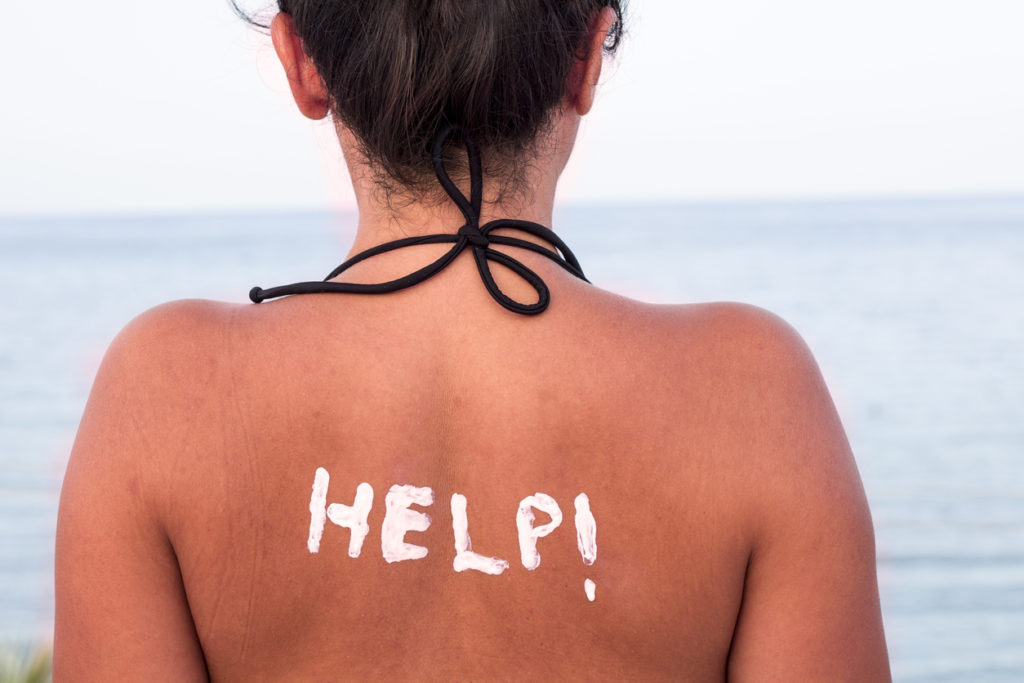In partnership with SA’s top medical aesthetic companies
Often we don’t notice the fact that we got sunburnt until much later when we’re home. But if you do notice you’ve had too much sun while still at the beach or pool, jump in to the water and quickly cool your skin. Then get out of the sun as quickly as you can.
Skin SOS
At home, have a cool shower or bath but make it a quick one. Avoid using any product containing soap, which can dry or irritate your skin. Use something like Obagi’s Gentle Rejuvenation System and a soap-free, hydrating body wash to clean all the salt or chemicals off your skin. Gently pat yourself dry and, while your skin is still slightly damp, moisturise well (avoiding any petroleum or oil-based products which may exacerbate the burn). A cold compress or sitting in front of a fan can be quite soothing.
Unless otherwise indicated, reduce swelling and calm redness by taking a nonsteroidal anti-inflammatory (like aspirin) or applying an over-the-counter 1% cortisone cream. There is also evidence that aloe vera helps to heal skin damage. It is also very soothing, which is why many after-sun products contain aloe. Lamelle Nourish Rescue Repair Gel specifically targets DNA damage and rescues skin that has been exposed to the sun.
Drink, drink and drink some more. Your body will draw fluid to the skin’s surface to start the damage repair, away from the rest of the body, which means that you could become dehydrated. Keep drinking water and some sort of electrolyte solution if possible, not only on the day you got sunburnt, but also while your body is healing. As well as keeping hydrated, remember to eat healthily. Your body is working hard to heal itself and needs the proper fuel to do so.
You won’t want anything touching your skin for a few days after a bad sunburn, so wear comfortable, loose clothing made from soft fabrics and use a good moisturiser like Neostrata Problem Dry Skin cream to help your skin heal faster. Sleeping on sunburnt skin can be difficult – sprinkle some powder on your sheets to reduce friction and use a fan in your bedroom to cool everything down.
For really hot and painful areas, apply a compress of soft fabric like muslin soaked in oatmeal water or fat-free milk, or apply Bulgarian yoghurt directly to your skin. Cool green teabags make great compresses for sunburnt eyelids. Moisturising is extra important – put your moisturiser in the fridge for cool relief!
Very importantly…
The number one rule once you are sunburnt is to stay out of the sun and use a high protection broad spectrum SPF. If you’re someone who forgets to reapply SPF, a great product for additional protection are Heliocare Capsules. Your sunburn will eventually fade and your skin will heal, but real damage has already been done. It takes between three and six months for a bad burn to heal properly at cellular level. Burning again on top of sunburn greatly increases your chances of skin cancer, not to mention premature ageing. Treatments such as Limelight and Acutip by Cutera can help sun damage and sun spots, while Pearl by Cutera is great for severe sun damage and skin resurfacing.
When to see a doctor
If you have a fever, chills or experience confusion, and if any sort of blistering occurs, it’s a good idea to visit your GP. If blisters do occur, leave them alone! Scratching or popping blisters can lead to infection, which will definitely mean a trip to the doctor.
One last thought
Some skin-care products, medications and even some food, such as celery, figs, fennel, parsley and limes, are known to make skin more photosensitive. Check your skincare products for alpha-hydroxy acids, beta-hydroxy acids and tretinoins (like Retin-A). Certain antifungal medications, some antihistamines, oral contraceptives, antibiotics, diuretics and even some anti-inflammatory drugs are all medications that may cause heightened photosensitivity. If you are taking any medication, check with your pharmacist whether this is the case – and be extra careful.
